Case Study Two: Analyzing Health Information - HLT54115
VerifiedAdded on 2023/05/29
|8
|2608
|363
Case Study
AI Summary
This document presents a comprehensive analysis of a nursing case study involving three clients with different health conditions. The case study addresses a 72-year-old male with unstable blood glucose levels and a foot ulcer, exploring the causes of his symptoms, including hypoglycemia and delayed wound healing, and detailing the necessary interventions by nurses, dieticians, and diagnostic personnel. Another part of the case study focuses on a patient with urinary tract infection and stroke, analyzing the causes of her condition, including catheterization and transient ischemic stroke, and the required interventions. Finally, the case study examines a pregnant woman with cystic fibrosis, discussing the genetic inheritance of the disease, the impact on her respiratory system, and the management of her condition during pregnancy, emphasizing the roles of nurses, respiratory therapists, and physiotherapists. The document provides references to support the analysis and recommendations.
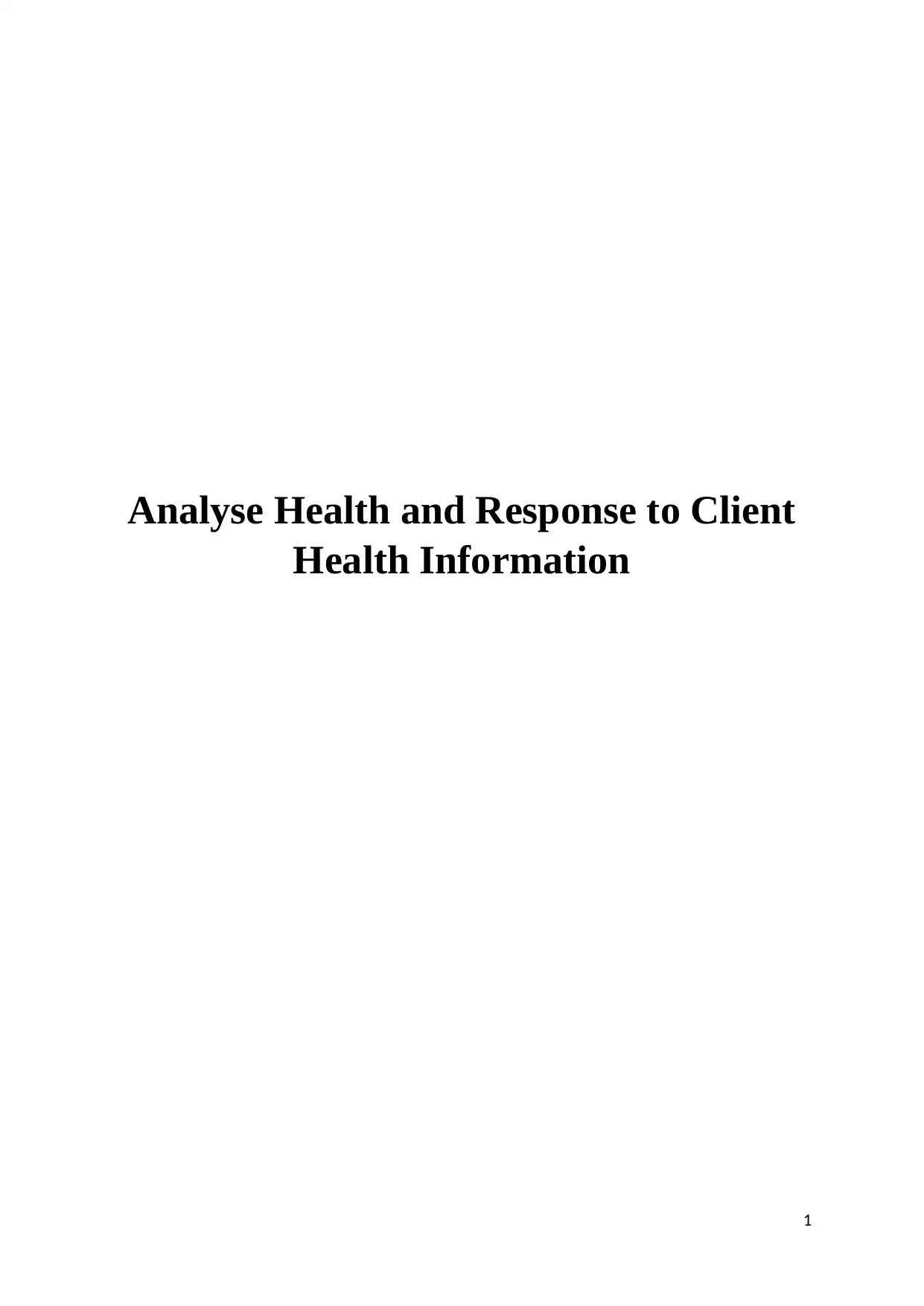
Analyse Health and Response to Client
Health Information
1
Health Information
1
Paraphrase This Document
Need a fresh take? Get an instant paraphrase of this document with our AI Paraphraser
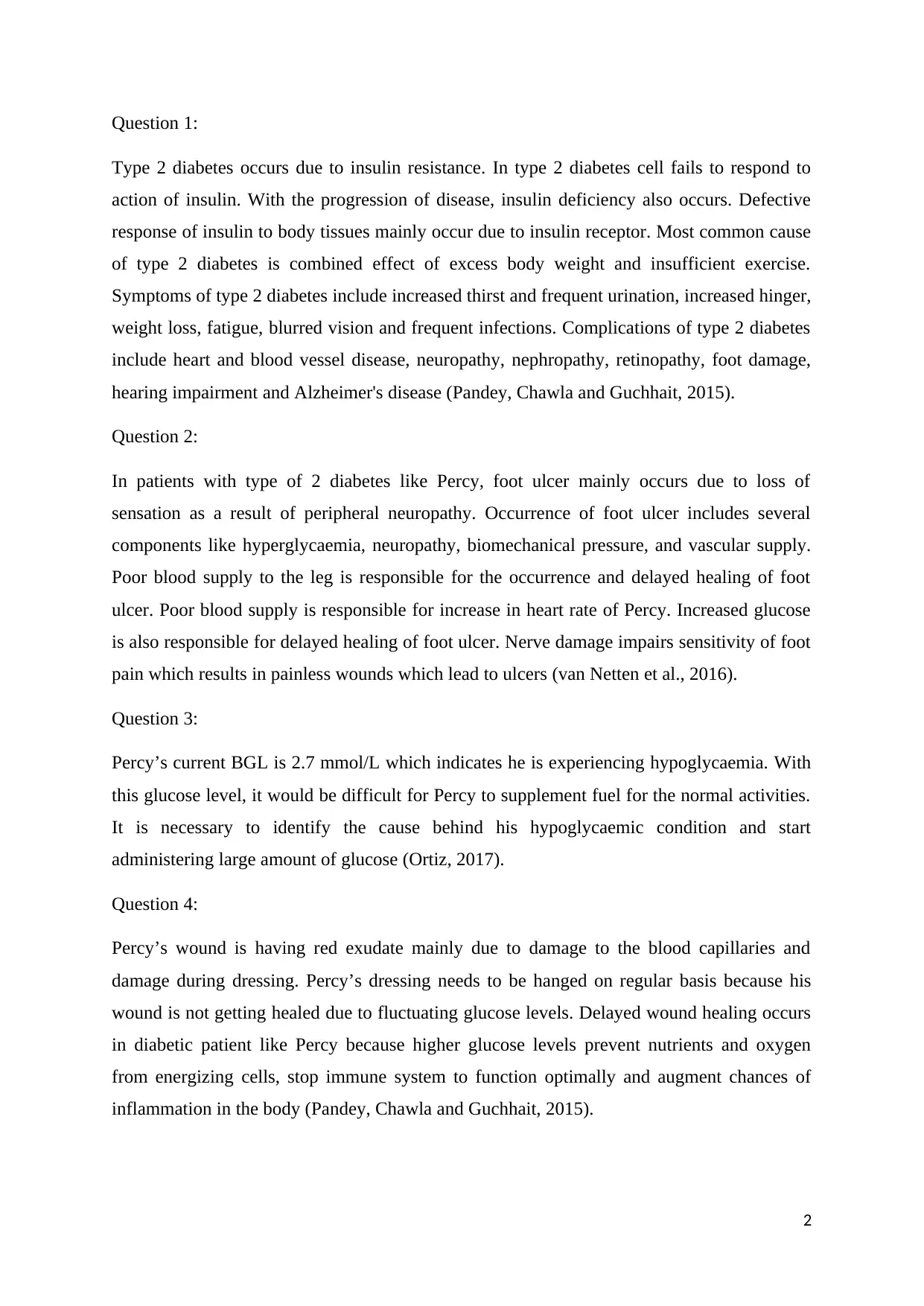
Question 1:
Type 2 diabetes occurs due to insulin resistance. In type 2 diabetes cell fails to respond to
action of insulin. With the progression of disease, insulin deficiency also occurs. Defective
response of insulin to body tissues mainly occur due to insulin receptor. Most common cause
of type 2 diabetes is combined effect of excess body weight and insufficient exercise.
Symptoms of type 2 diabetes include increased thirst and frequent urination, increased hinger,
weight loss, fatigue, blurred vision and frequent infections. Complications of type 2 diabetes
include heart and blood vessel disease, neuropathy, nephropathy, retinopathy, foot damage,
hearing impairment and Alzheimer's disease (Pandey, Chawla and Guchhait, 2015).
Question 2:
In patients with type of 2 diabetes like Percy, foot ulcer mainly occurs due to loss of
sensation as a result of peripheral neuropathy. Occurrence of foot ulcer includes several
components like hyperglycaemia, neuropathy, biomechanical pressure, and vascular supply.
Poor blood supply to the leg is responsible for the occurrence and delayed healing of foot
ulcer. Poor blood supply is responsible for increase in heart rate of Percy. Increased glucose
is also responsible for delayed healing of foot ulcer. Nerve damage impairs sensitivity of foot
pain which results in painless wounds which lead to ulcers (van Netten et al., 2016).
Question 3:
Percy’s current BGL is 2.7 mmol/L which indicates he is experiencing hypoglycaemia. With
this glucose level, it would be difficult for Percy to supplement fuel for the normal activities.
It is necessary to identify the cause behind his hypoglycaemic condition and start
administering large amount of glucose (Ortiz, 2017).
Question 4:
Percy’s wound is having red exudate mainly due to damage to the blood capillaries and
damage during dressing. Percy’s dressing needs to be hanged on regular basis because his
wound is not getting healed due to fluctuating glucose levels. Delayed wound healing occurs
in diabetic patient like Percy because higher glucose levels prevent nutrients and oxygen
from energizing cells, stop immune system to function optimally and augment chances of
inflammation in the body (Pandey, Chawla and Guchhait, 2015).
2
Type 2 diabetes occurs due to insulin resistance. In type 2 diabetes cell fails to respond to
action of insulin. With the progression of disease, insulin deficiency also occurs. Defective
response of insulin to body tissues mainly occur due to insulin receptor. Most common cause
of type 2 diabetes is combined effect of excess body weight and insufficient exercise.
Symptoms of type 2 diabetes include increased thirst and frequent urination, increased hinger,
weight loss, fatigue, blurred vision and frequent infections. Complications of type 2 diabetes
include heart and blood vessel disease, neuropathy, nephropathy, retinopathy, foot damage,
hearing impairment and Alzheimer's disease (Pandey, Chawla and Guchhait, 2015).
Question 2:
In patients with type of 2 diabetes like Percy, foot ulcer mainly occurs due to loss of
sensation as a result of peripheral neuropathy. Occurrence of foot ulcer includes several
components like hyperglycaemia, neuropathy, biomechanical pressure, and vascular supply.
Poor blood supply to the leg is responsible for the occurrence and delayed healing of foot
ulcer. Poor blood supply is responsible for increase in heart rate of Percy. Increased glucose
is also responsible for delayed healing of foot ulcer. Nerve damage impairs sensitivity of foot
pain which results in painless wounds which lead to ulcers (van Netten et al., 2016).
Question 3:
Percy’s current BGL is 2.7 mmol/L which indicates he is experiencing hypoglycaemia. With
this glucose level, it would be difficult for Percy to supplement fuel for the normal activities.
It is necessary to identify the cause behind his hypoglycaemic condition and start
administering large amount of glucose (Ortiz, 2017).
Question 4:
Percy’s wound is having red exudate mainly due to damage to the blood capillaries and
damage during dressing. Percy’s dressing needs to be hanged on regular basis because his
wound is not getting healed due to fluctuating glucose levels. Delayed wound healing occurs
in diabetic patient like Percy because higher glucose levels prevent nutrients and oxygen
from energizing cells, stop immune system to function optimally and augment chances of
inflammation in the body (Pandey, Chawla and Guchhait, 2015).
2
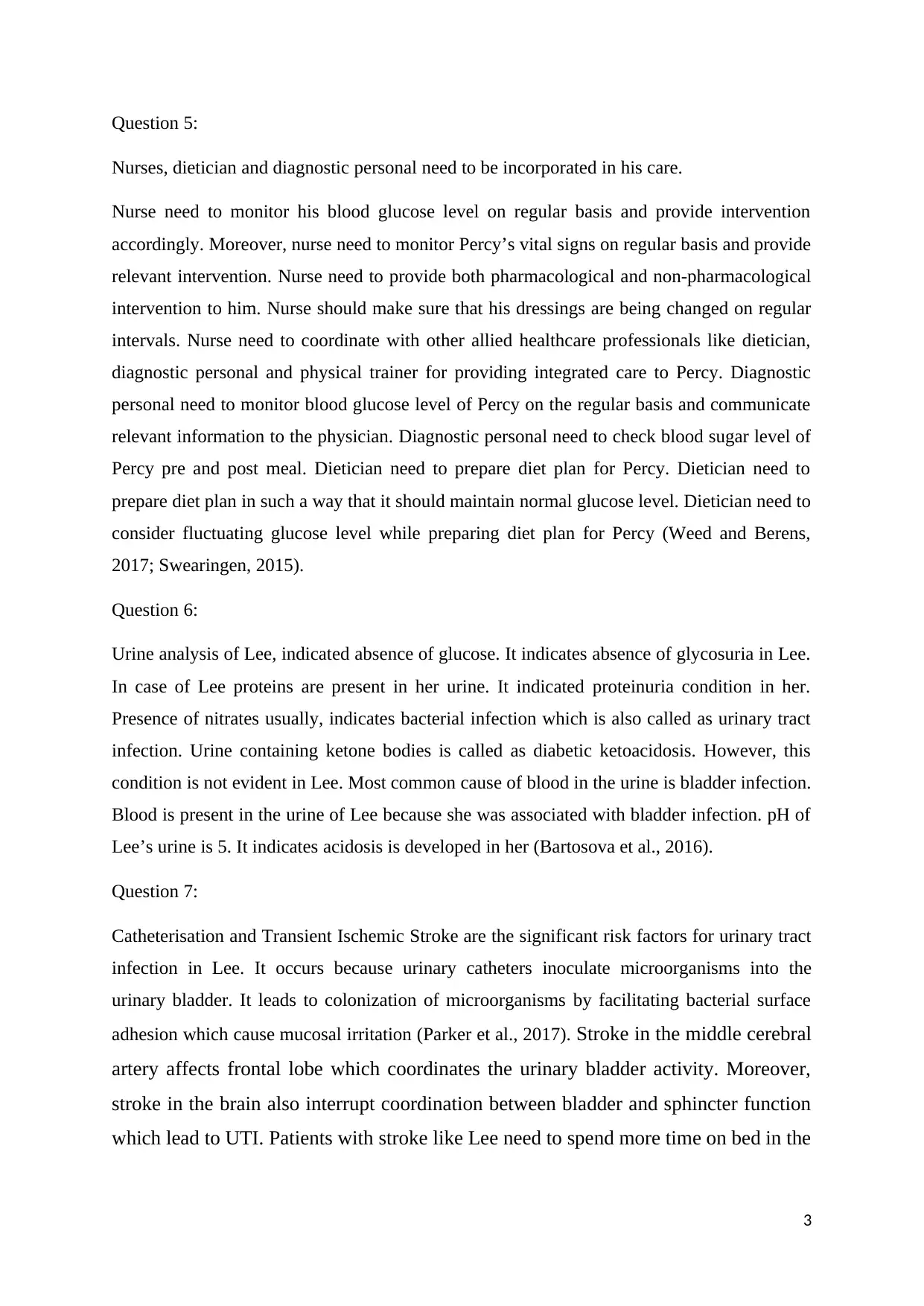
Question 5:
Nurses, dietician and diagnostic personal need to be incorporated in his care.
Nurse need to monitor his blood glucose level on regular basis and provide intervention
accordingly. Moreover, nurse need to monitor Percy’s vital signs on regular basis and provide
relevant intervention. Nurse need to provide both pharmacological and non-pharmacological
intervention to him. Nurse should make sure that his dressings are being changed on regular
intervals. Nurse need to coordinate with other allied healthcare professionals like dietician,
diagnostic personal and physical trainer for providing integrated care to Percy. Diagnostic
personal need to monitor blood glucose level of Percy on the regular basis and communicate
relevant information to the physician. Diagnostic personal need to check blood sugar level of
Percy pre and post meal. Dietician need to prepare diet plan for Percy. Dietician need to
prepare diet plan in such a way that it should maintain normal glucose level. Dietician need to
consider fluctuating glucose level while preparing diet plan for Percy (Weed and Berens,
2017; Swearingen, 2015).
Question 6:
Urine analysis of Lee, indicated absence of glucose. It indicates absence of glycosuria in Lee.
In case of Lee proteins are present in her urine. It indicated proteinuria condition in her.
Presence of nitrates usually, indicates bacterial infection which is also called as urinary tract
infection. Urine containing ketone bodies is called as diabetic ketoacidosis. However, this
condition is not evident in Lee. Most common cause of blood in the urine is bladder infection.
Blood is present in the urine of Lee because she was associated with bladder infection. pH of
Lee’s urine is 5. It indicates acidosis is developed in her (Bartosova et al., 2016).
Question 7:
Catheterisation and Transient Ischemic Stroke are the significant risk factors for urinary tract
infection in Lee. It occurs because urinary catheters inoculate microorganisms into the
urinary bladder. It leads to colonization of microorganisms by facilitating bacterial surface
adhesion which cause mucosal irritation (Parker et al., 2017). Stroke in the middle cerebral
artery affects frontal lobe which coordinates the urinary bladder activity. Moreover,
stroke in the brain also interrupt coordination between bladder and sphincter function
which lead to UTI. Patients with stroke like Lee need to spend more time on bed in the
3
Nurses, dietician and diagnostic personal need to be incorporated in his care.
Nurse need to monitor his blood glucose level on regular basis and provide intervention
accordingly. Moreover, nurse need to monitor Percy’s vital signs on regular basis and provide
relevant intervention. Nurse need to provide both pharmacological and non-pharmacological
intervention to him. Nurse should make sure that his dressings are being changed on regular
intervals. Nurse need to coordinate with other allied healthcare professionals like dietician,
diagnostic personal and physical trainer for providing integrated care to Percy. Diagnostic
personal need to monitor blood glucose level of Percy on the regular basis and communicate
relevant information to the physician. Diagnostic personal need to check blood sugar level of
Percy pre and post meal. Dietician need to prepare diet plan for Percy. Dietician need to
prepare diet plan in such a way that it should maintain normal glucose level. Dietician need to
consider fluctuating glucose level while preparing diet plan for Percy (Weed and Berens,
2017; Swearingen, 2015).
Question 6:
Urine analysis of Lee, indicated absence of glucose. It indicates absence of glycosuria in Lee.
In case of Lee proteins are present in her urine. It indicated proteinuria condition in her.
Presence of nitrates usually, indicates bacterial infection which is also called as urinary tract
infection. Urine containing ketone bodies is called as diabetic ketoacidosis. However, this
condition is not evident in Lee. Most common cause of blood in the urine is bladder infection.
Blood is present in the urine of Lee because she was associated with bladder infection. pH of
Lee’s urine is 5. It indicates acidosis is developed in her (Bartosova et al., 2016).
Question 7:
Catheterisation and Transient Ischemic Stroke are the significant risk factors for urinary tract
infection in Lee. It occurs because urinary catheters inoculate microorganisms into the
urinary bladder. It leads to colonization of microorganisms by facilitating bacterial surface
adhesion which cause mucosal irritation (Parker et al., 2017). Stroke in the middle cerebral
artery affects frontal lobe which coordinates the urinary bladder activity. Moreover,
stroke in the brain also interrupt coordination between bladder and sphincter function
which lead to UTI. Patients with stroke like Lee need to spend more time on bed in the
3
⊘ This is a preview!⊘
Do you want full access?
Subscribe today to unlock all pages.

Trusted by 1+ million students worldwide
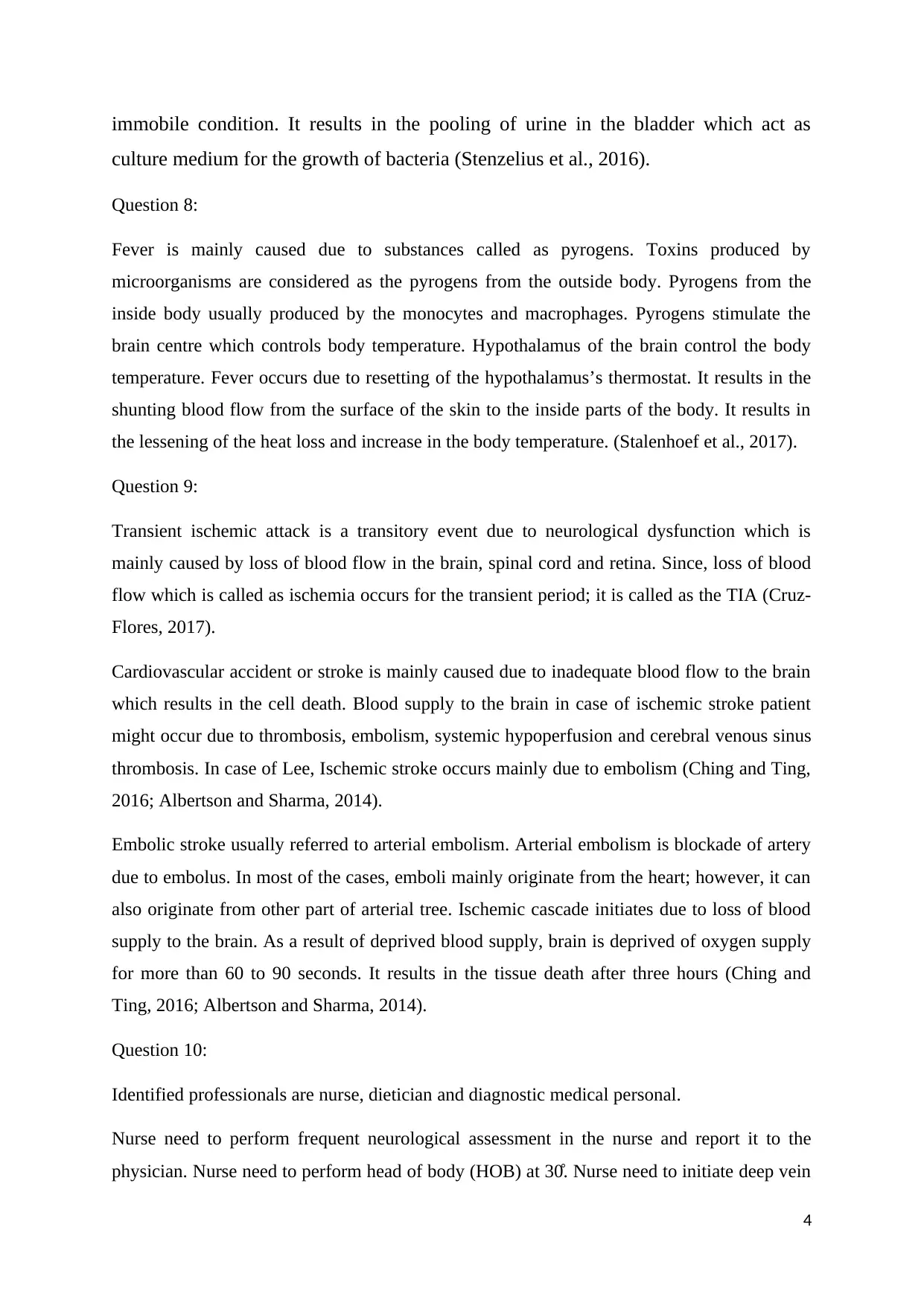
immobile condition. It results in the pooling of urine in the bladder which act as
culture medium for the growth of bacteria (Stenzelius et al., 2016).
Question 8:
Fever is mainly caused due to substances called as pyrogens. Toxins produced by
microorganisms are considered as the pyrogens from the outside body. Pyrogens from the
inside body usually produced by the monocytes and macrophages. Pyrogens stimulate the
brain centre which controls body temperature. Hypothalamus of the brain control the body
temperature. Fever occurs due to resetting of the hypothalamus’s thermostat. It results in the
shunting blood flow from the surface of the skin to the inside parts of the body. It results in
the lessening of the heat loss and increase in the body temperature. (Stalenhoef et al., 2017).
Question 9:
Transient ischemic attack is a transitory event due to neurological dysfunction which is
mainly caused by loss of blood flow in the brain, spinal cord and retina. Since, loss of blood
flow which is called as ischemia occurs for the transient period; it is called as the TIA (Cruz-
Flores, 2017).
Cardiovascular accident or stroke is mainly caused due to inadequate blood flow to the brain
which results in the cell death. Blood supply to the brain in case of ischemic stroke patient
might occur due to thrombosis, embolism, systemic hypoperfusion and cerebral venous sinus
thrombosis. In case of Lee, Ischemic stroke occurs mainly due to embolism (Ching and Ting,
2016; Albertson and Sharma, 2014).
Embolic stroke usually referred to arterial embolism. Arterial embolism is blockade of artery
due to embolus. In most of the cases, emboli mainly originate from the heart; however, it can
also originate from other part of arterial tree. Ischemic cascade initiates due to loss of blood
supply to the brain. As a result of deprived blood supply, brain is deprived of oxygen supply
for more than 60 to 90 seconds. It results in the tissue death after three hours (Ching and
Ting, 2016; Albertson and Sharma, 2014).
Question 10:
Identified professionals are nurse, dietician and diagnostic medical personal.
Nurse need to perform frequent neurological assessment in the nurse and report it to the
physician. Nurse need to perform head of body (HOB) at 30̊. Nurse need to initiate deep vein
4
culture medium for the growth of bacteria (Stenzelius et al., 2016).
Question 8:
Fever is mainly caused due to substances called as pyrogens. Toxins produced by
microorganisms are considered as the pyrogens from the outside body. Pyrogens from the
inside body usually produced by the monocytes and macrophages. Pyrogens stimulate the
brain centre which controls body temperature. Hypothalamus of the brain control the body
temperature. Fever occurs due to resetting of the hypothalamus’s thermostat. It results in the
shunting blood flow from the surface of the skin to the inside parts of the body. It results in
the lessening of the heat loss and increase in the body temperature. (Stalenhoef et al., 2017).
Question 9:
Transient ischemic attack is a transitory event due to neurological dysfunction which is
mainly caused by loss of blood flow in the brain, spinal cord and retina. Since, loss of blood
flow which is called as ischemia occurs for the transient period; it is called as the TIA (Cruz-
Flores, 2017).
Cardiovascular accident or stroke is mainly caused due to inadequate blood flow to the brain
which results in the cell death. Blood supply to the brain in case of ischemic stroke patient
might occur due to thrombosis, embolism, systemic hypoperfusion and cerebral venous sinus
thrombosis. In case of Lee, Ischemic stroke occurs mainly due to embolism (Ching and Ting,
2016; Albertson and Sharma, 2014).
Embolic stroke usually referred to arterial embolism. Arterial embolism is blockade of artery
due to embolus. In most of the cases, emboli mainly originate from the heart; however, it can
also originate from other part of arterial tree. Ischemic cascade initiates due to loss of blood
supply to the brain. As a result of deprived blood supply, brain is deprived of oxygen supply
for more than 60 to 90 seconds. It results in the tissue death after three hours (Ching and
Ting, 2016; Albertson and Sharma, 2014).
Question 10:
Identified professionals are nurse, dietician and diagnostic medical personal.
Nurse need to perform frequent neurological assessment in the nurse and report it to the
physician. Nurse need to perform head of body (HOB) at 30̊. Nurse need to initiate deep vein
4
Paraphrase This Document
Need a fresh take? Get an instant paraphrase of this document with our AI Paraphraser
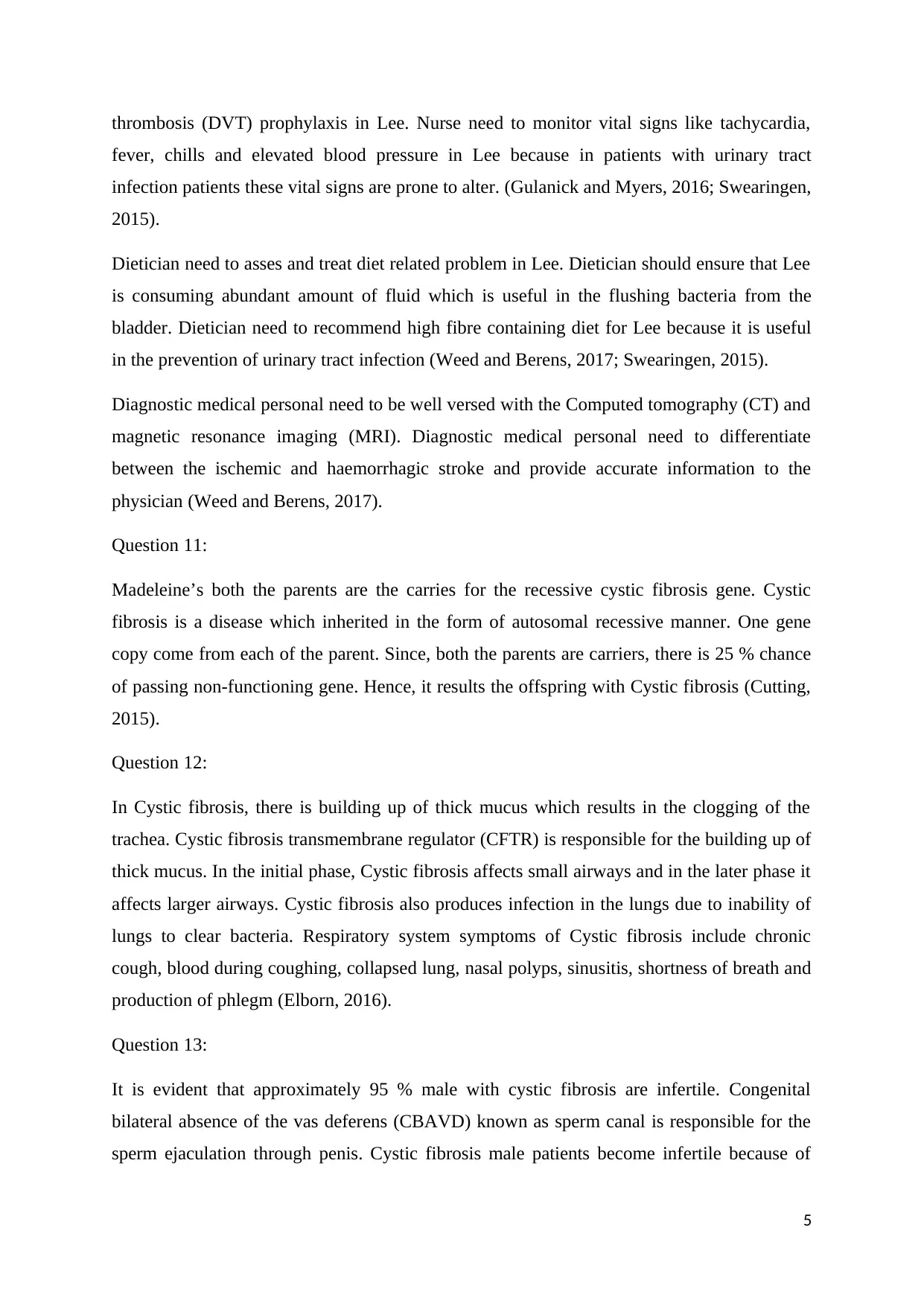
thrombosis (DVT) prophylaxis in Lee. Nurse need to monitor vital signs like tachycardia,
fever, chills and elevated blood pressure in Lee because in patients with urinary tract
infection patients these vital signs are prone to alter. (Gulanick and Myers, 2016; Swearingen,
2015).
Dietician need to asses and treat diet related problem in Lee. Dietician should ensure that Lee
is consuming abundant amount of fluid which is useful in the flushing bacteria from the
bladder. Dietician need to recommend high fibre containing diet for Lee because it is useful
in the prevention of urinary tract infection (Weed and Berens, 2017; Swearingen, 2015).
Diagnostic medical personal need to be well versed with the Computed tomography (CT) and
magnetic resonance imaging (MRI). Diagnostic medical personal need to differentiate
between the ischemic and haemorrhagic stroke and provide accurate information to the
physician (Weed and Berens, 2017).
Question 11:
Madeleine’s both the parents are the carries for the recessive cystic fibrosis gene. Cystic
fibrosis is a disease which inherited in the form of autosomal recessive manner. One gene
copy come from each of the parent. Since, both the parents are carriers, there is 25 % chance
of passing non-functioning gene. Hence, it results the offspring with Cystic fibrosis (Cutting,
2015).
Question 12:
In Cystic fibrosis, there is building up of thick mucus which results in the clogging of the
trachea. Cystic fibrosis transmembrane regulator (CFTR) is responsible for the building up of
thick mucus. In the initial phase, Cystic fibrosis affects small airways and in the later phase it
affects larger airways. Cystic fibrosis also produces infection in the lungs due to inability of
lungs to clear bacteria. Respiratory system symptoms of Cystic fibrosis include chronic
cough, blood during coughing, collapsed lung, nasal polyps, sinusitis, shortness of breath and
production of phlegm (Elborn, 2016).
Question 13:
It is evident that approximately 95 % male with cystic fibrosis are infertile. Congenital
bilateral absence of the vas deferens (CBAVD) known as sperm canal is responsible for the
sperm ejaculation through penis. Cystic fibrosis male patients become infertile because of
5
fever, chills and elevated blood pressure in Lee because in patients with urinary tract
infection patients these vital signs are prone to alter. (Gulanick and Myers, 2016; Swearingen,
2015).
Dietician need to asses and treat diet related problem in Lee. Dietician should ensure that Lee
is consuming abundant amount of fluid which is useful in the flushing bacteria from the
bladder. Dietician need to recommend high fibre containing diet for Lee because it is useful
in the prevention of urinary tract infection (Weed and Berens, 2017; Swearingen, 2015).
Diagnostic medical personal need to be well versed with the Computed tomography (CT) and
magnetic resonance imaging (MRI). Diagnostic medical personal need to differentiate
between the ischemic and haemorrhagic stroke and provide accurate information to the
physician (Weed and Berens, 2017).
Question 11:
Madeleine’s both the parents are the carries for the recessive cystic fibrosis gene. Cystic
fibrosis is a disease which inherited in the form of autosomal recessive manner. One gene
copy come from each of the parent. Since, both the parents are carriers, there is 25 % chance
of passing non-functioning gene. Hence, it results the offspring with Cystic fibrosis (Cutting,
2015).
Question 12:
In Cystic fibrosis, there is building up of thick mucus which results in the clogging of the
trachea. Cystic fibrosis transmembrane regulator (CFTR) is responsible for the building up of
thick mucus. In the initial phase, Cystic fibrosis affects small airways and in the later phase it
affects larger airways. Cystic fibrosis also produces infection in the lungs due to inability of
lungs to clear bacteria. Respiratory system symptoms of Cystic fibrosis include chronic
cough, blood during coughing, collapsed lung, nasal polyps, sinusitis, shortness of breath and
production of phlegm (Elborn, 2016).
Question 13:
It is evident that approximately 95 % male with cystic fibrosis are infertile. Congenital
bilateral absence of the vas deferens (CBAVD) known as sperm canal is responsible for the
sperm ejaculation through penis. Cystic fibrosis male patients become infertile because of
5
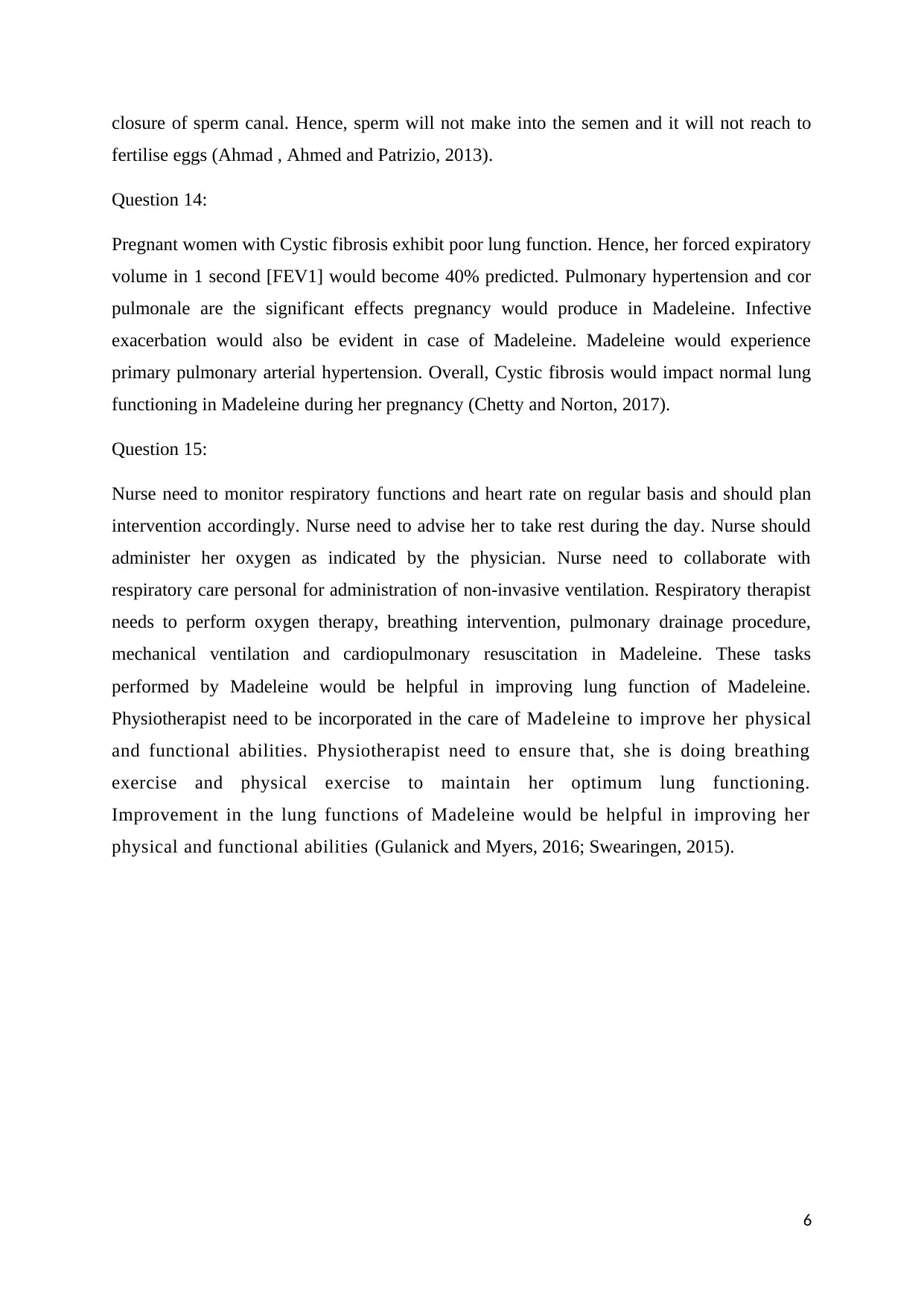
closure of sperm canal. Hence, sperm will not make into the semen and it will not reach to
fertilise eggs (Ahmad , Ahmed and Patrizio, 2013).
Question 14:
Pregnant women with Cystic fibrosis exhibit poor lung function. Hence, her forced expiratory
volume in 1 second [FEV1] would become 40% predicted. Pulmonary hypertension and cor
pulmonale are the significant effects pregnancy would produce in Madeleine. Infective
exacerbation would also be evident in case of Madeleine. Madeleine would experience
primary pulmonary arterial hypertension. Overall, Cystic fibrosis would impact normal lung
functioning in Madeleine during her pregnancy (Chetty and Norton, 2017).
Question 15:
Nurse need to monitor respiratory functions and heart rate on regular basis and should plan
intervention accordingly. Nurse need to advise her to take rest during the day. Nurse should
administer her oxygen as indicated by the physician. Nurse need to collaborate with
respiratory care personal for administration of non-invasive ventilation. Respiratory therapist
needs to perform oxygen therapy, breathing intervention, pulmonary drainage procedure,
mechanical ventilation and cardiopulmonary resuscitation in Madeleine. These tasks
performed by Madeleine would be helpful in improving lung function of Madeleine.
Physiotherapist need to be incorporated in the care of Madeleine to improve her physical
and functional abilities. Physiotherapist need to ensure that, she is doing breathing
exercise and physical exercise to maintain her optimum lung functioning.
Improvement in the lung functions of Madeleine would be helpful in improving her
physical and functional abilities (Gulanick and Myers, 2016; Swearingen, 2015).
6
fertilise eggs (Ahmad , Ahmed and Patrizio, 2013).
Question 14:
Pregnant women with Cystic fibrosis exhibit poor lung function. Hence, her forced expiratory
volume in 1 second [FEV1] would become 40% predicted. Pulmonary hypertension and cor
pulmonale are the significant effects pregnancy would produce in Madeleine. Infective
exacerbation would also be evident in case of Madeleine. Madeleine would experience
primary pulmonary arterial hypertension. Overall, Cystic fibrosis would impact normal lung
functioning in Madeleine during her pregnancy (Chetty and Norton, 2017).
Question 15:
Nurse need to monitor respiratory functions and heart rate on regular basis and should plan
intervention accordingly. Nurse need to advise her to take rest during the day. Nurse should
administer her oxygen as indicated by the physician. Nurse need to collaborate with
respiratory care personal for administration of non-invasive ventilation. Respiratory therapist
needs to perform oxygen therapy, breathing intervention, pulmonary drainage procedure,
mechanical ventilation and cardiopulmonary resuscitation in Madeleine. These tasks
performed by Madeleine would be helpful in improving lung function of Madeleine.
Physiotherapist need to be incorporated in the care of Madeleine to improve her physical
and functional abilities. Physiotherapist need to ensure that, she is doing breathing
exercise and physical exercise to maintain her optimum lung functioning.
Improvement in the lung functions of Madeleine would be helpful in improving her
physical and functional abilities (Gulanick and Myers, 2016; Swearingen, 2015).
6
⊘ This is a preview!⊘
Do you want full access?
Subscribe today to unlock all pages.

Trusted by 1+ million students worldwide
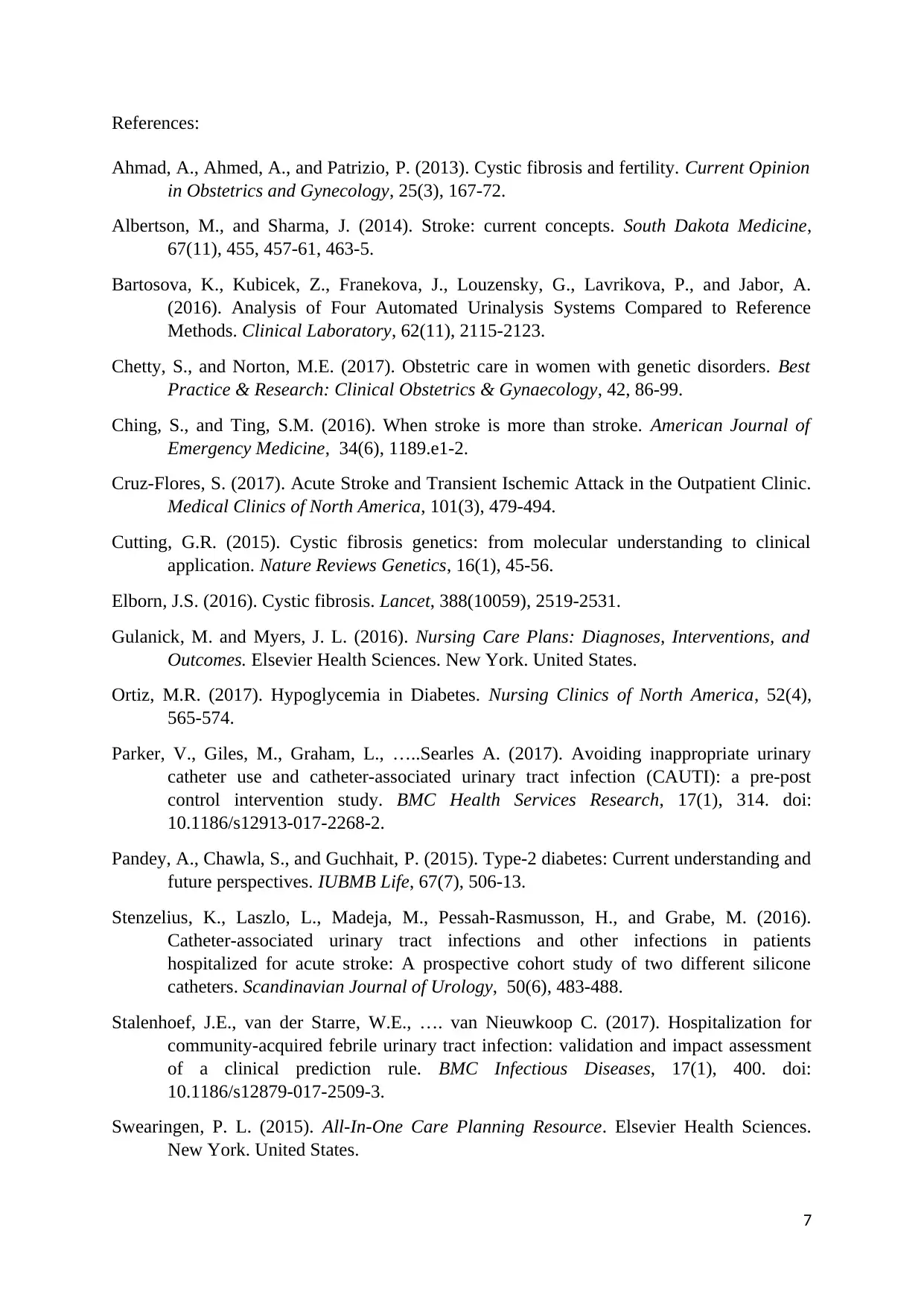
References:
Ahmad, A., Ahmed, A., and Patrizio, P. (2013). Cystic fibrosis and fertility. Current Opinion
in Obstetrics and Gynecology, 25(3), 167-72.
Albertson, M., and Sharma, J. (2014). Stroke: current concepts. South Dakota Medicine,
67(11), 455, 457-61, 463-5.
Bartosova, K., Kubicek, Z., Franekova, J., Louzensky, G., Lavrikova, P., and Jabor, A.
(2016). Analysis of Four Automated Urinalysis Systems Compared to Reference
Methods. Clinical Laboratory, 62(11), 2115-2123.
Chetty, S., and Norton, M.E. (2017). Obstetric care in women with genetic disorders. Best
Practice & Research: Clinical Obstetrics & Gynaecology, 42, 86-99.
Ching, S., and Ting, S.M. (2016). When stroke is more than stroke. American Journal of
Emergency Medicine, 34(6), 1189.e1-2.
Cruz-Flores, S. (2017). Acute Stroke and Transient Ischemic Attack in the Outpatient Clinic.
Medical Clinics of North America, 101(3), 479-494.
Cutting, G.R. (2015). Cystic fibrosis genetics: from molecular understanding to clinical
application. Nature Reviews Genetics, 16(1), 45-56.
Elborn, J.S. (2016). Cystic fibrosis. Lancet, 388(10059), 2519-2531.
Gulanick, M. and Myers, J. L. (2016). Nursing Care Plans: Diagnoses, Interventions, and
Outcomes. Elsevier Health Sciences. New York. United States.
Ortiz, M.R. (2017). Hypoglycemia in Diabetes. Nursing Clinics of North America, 52(4),
565-574.
Parker, V., Giles, M., Graham, L., …..Searles A. (2017). Avoiding inappropriate urinary
catheter use and catheter-associated urinary tract infection (CAUTI): a pre-post
control intervention study. BMC Health Services Research, 17(1), 314. doi:
10.1186/s12913-017-2268-2.
Pandey, A., Chawla, S., and Guchhait, P. (2015). Type-2 diabetes: Current understanding and
future perspectives. IUBMB Life, 67(7), 506-13.
Stenzelius, K., Laszlo, L., Madeja, M., Pessah-Rasmusson, H., and Grabe, M. (2016).
Catheter-associated urinary tract infections and other infections in patients
hospitalized for acute stroke: A prospective cohort study of two different silicone
catheters. Scandinavian Journal of Urology, 50(6), 483-488.
Stalenhoef, J.E., van der Starre, W.E., …. van Nieuwkoop C. (2017). Hospitalization for
community-acquired febrile urinary tract infection: validation and impact assessment
of a clinical prediction rule. BMC Infectious Diseases, 17(1), 400. doi:
10.1186/s12879-017-2509-3.
Swearingen, P. L. (2015). All-In-One Care Planning Resource. Elsevier Health Sciences.
New York. United States.
7
Ahmad, A., Ahmed, A., and Patrizio, P. (2013). Cystic fibrosis and fertility. Current Opinion
in Obstetrics and Gynecology, 25(3), 167-72.
Albertson, M., and Sharma, J. (2014). Stroke: current concepts. South Dakota Medicine,
67(11), 455, 457-61, 463-5.
Bartosova, K., Kubicek, Z., Franekova, J., Louzensky, G., Lavrikova, P., and Jabor, A.
(2016). Analysis of Four Automated Urinalysis Systems Compared to Reference
Methods. Clinical Laboratory, 62(11), 2115-2123.
Chetty, S., and Norton, M.E. (2017). Obstetric care in women with genetic disorders. Best
Practice & Research: Clinical Obstetrics & Gynaecology, 42, 86-99.
Ching, S., and Ting, S.M. (2016). When stroke is more than stroke. American Journal of
Emergency Medicine, 34(6), 1189.e1-2.
Cruz-Flores, S. (2017). Acute Stroke and Transient Ischemic Attack in the Outpatient Clinic.
Medical Clinics of North America, 101(3), 479-494.
Cutting, G.R. (2015). Cystic fibrosis genetics: from molecular understanding to clinical
application. Nature Reviews Genetics, 16(1), 45-56.
Elborn, J.S. (2016). Cystic fibrosis. Lancet, 388(10059), 2519-2531.
Gulanick, M. and Myers, J. L. (2016). Nursing Care Plans: Diagnoses, Interventions, and
Outcomes. Elsevier Health Sciences. New York. United States.
Ortiz, M.R. (2017). Hypoglycemia in Diabetes. Nursing Clinics of North America, 52(4),
565-574.
Parker, V., Giles, M., Graham, L., …..Searles A. (2017). Avoiding inappropriate urinary
catheter use and catheter-associated urinary tract infection (CAUTI): a pre-post
control intervention study. BMC Health Services Research, 17(1), 314. doi:
10.1186/s12913-017-2268-2.
Pandey, A., Chawla, S., and Guchhait, P. (2015). Type-2 diabetes: Current understanding and
future perspectives. IUBMB Life, 67(7), 506-13.
Stenzelius, K., Laszlo, L., Madeja, M., Pessah-Rasmusson, H., and Grabe, M. (2016).
Catheter-associated urinary tract infections and other infections in patients
hospitalized for acute stroke: A prospective cohort study of two different silicone
catheters. Scandinavian Journal of Urology, 50(6), 483-488.
Stalenhoef, J.E., van der Starre, W.E., …. van Nieuwkoop C. (2017). Hospitalization for
community-acquired febrile urinary tract infection: validation and impact assessment
of a clinical prediction rule. BMC Infectious Diseases, 17(1), 400. doi:
10.1186/s12879-017-2509-3.
Swearingen, P. L. (2015). All-In-One Care Planning Resource. Elsevier Health Sciences.
New York. United States.
7
Paraphrase This Document
Need a fresh take? Get an instant paraphrase of this document with our AI Paraphraser
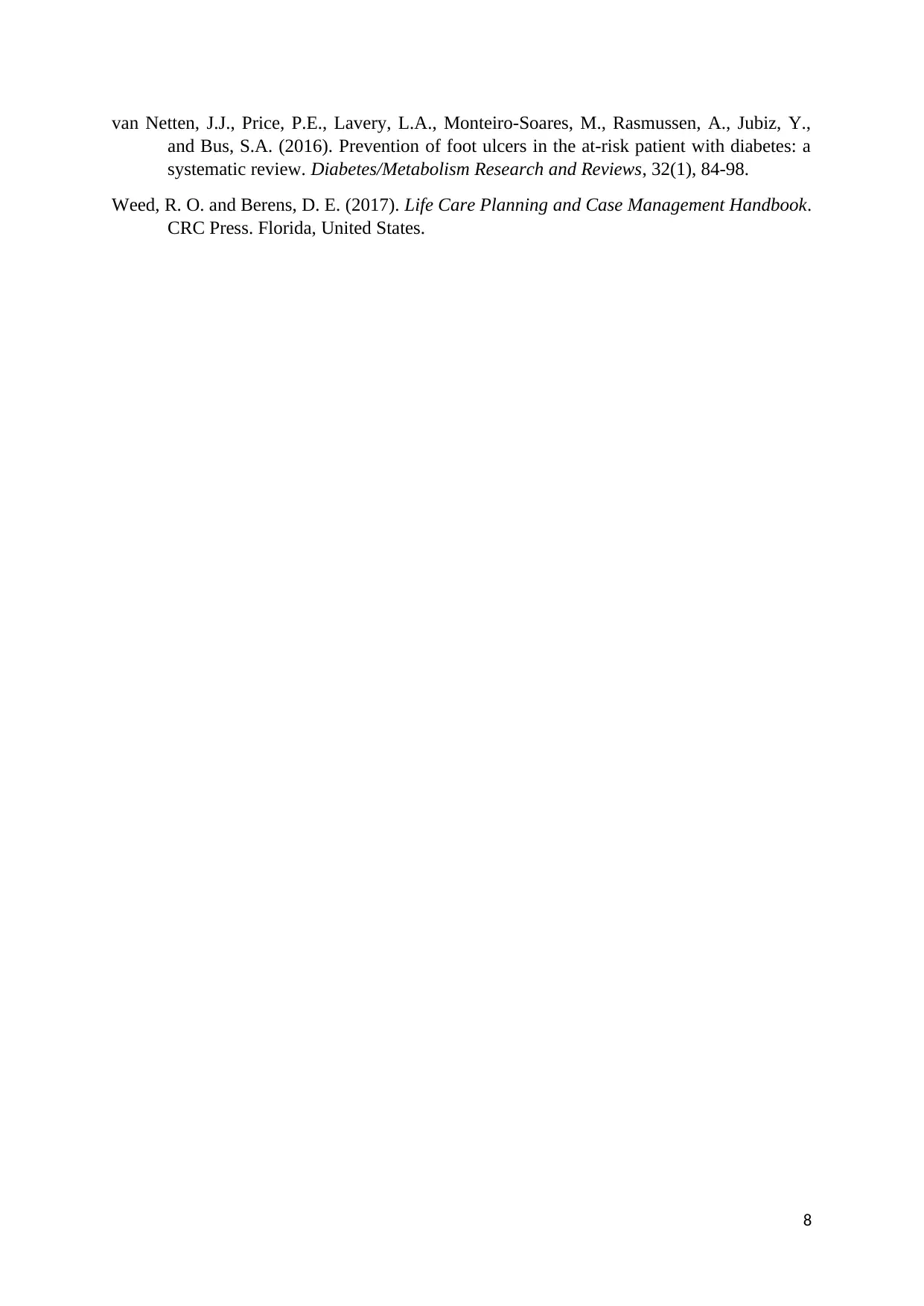
van Netten, J.J., Price, P.E., Lavery, L.A., Monteiro-Soares, M., Rasmussen, A., Jubiz, Y.,
and Bus, S.A. (2016). Prevention of foot ulcers in the at-risk patient with diabetes: a
systematic review. Diabetes/Metabolism Research and Reviews, 32(1), 84-98.
Weed, R. O. and Berens, D. E. (2017). Life Care Planning and Case Management Handbook.
CRC Press. Florida, United States.
8
and Bus, S.A. (2016). Prevention of foot ulcers in the at-risk patient with diabetes: a
systematic review. Diabetes/Metabolism Research and Reviews, 32(1), 84-98.
Weed, R. O. and Berens, D. E. (2017). Life Care Planning and Case Management Handbook.
CRC Press. Florida, United States.
8
1 out of 8
Related Documents
Your All-in-One AI-Powered Toolkit for Academic Success.
+13062052269
info@desklib.com
Available 24*7 on WhatsApp / Email
![[object Object]](/_next/static/media/star-bottom.7253800d.svg)
Unlock your academic potential
Copyright © 2020–2025 A2Z Services. All Rights Reserved. Developed and managed by ZUCOL.





